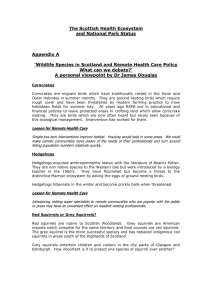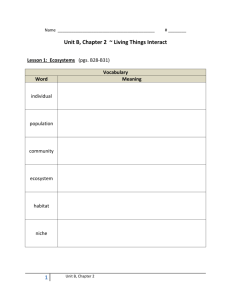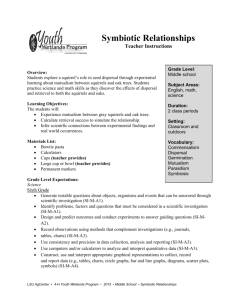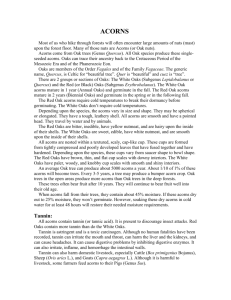Unit 2 Test
advertisement
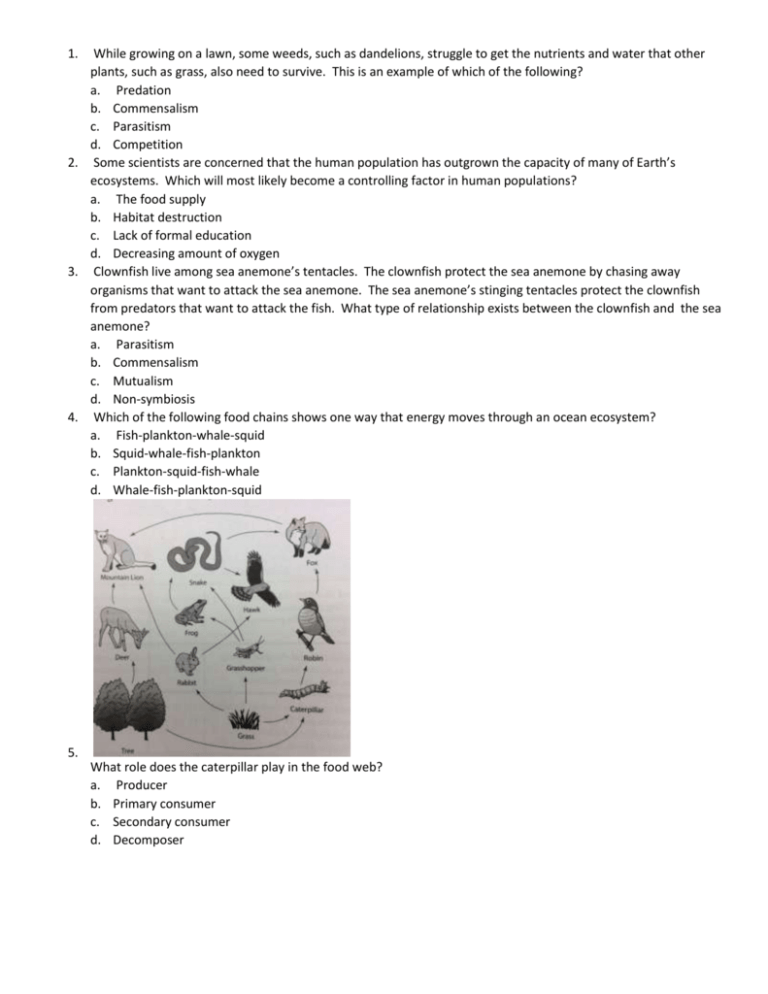
1. While growing on a lawn, some weeds, such as dandelions, struggle to get the nutrients and water that other plants, such as grass, also need to survive. This is an example of which of the following? a. Predation b. Commensalism c. Parasitism d. Competition 2. Some scientists are concerned that the human population has outgrown the capacity of many of Earth’s ecosystems. Which will most likely become a controlling factor in human populations? a. The food supply b. Habitat destruction c. Lack of formal education d. Decreasing amount of oxygen 3. Clownfish live among sea anemone’s tentacles. The clownfish protect the sea anemone by chasing away organisms that want to attack the sea anemone. The sea anemone’s stinging tentacles protect the clownfish from predators that want to attack the fish. What type of relationship exists between the clownfish and the sea anemone? a. Parasitism b. Commensalism c. Mutualism d. Non-symbiosis 4. Which of the following food chains shows one way that energy moves through an ocean ecosystem? a. Fish-plankton-whale-squid b. Squid-whale-fish-plankton c. Plankton-squid-fish-whale d. Whale-fish-plankton-squid 5. What role does the caterpillar play in the food web? a. Producer b. Primary consumer c. Secondary consumer d. Decomposer 6. A food web consists of many interconnected food chains. Which of the following represents one of the food chains in the food web shown in the diagram? a. Fox-mouse-woodpecker b. Plants-rabbit-woodpecker c. Plants-mouse-snake d. Snake-mouse-termite 7. 8. 9. 10. 11. In an ecosystem containing the food web shown, what might happen if the weasels diappear? a. The number of snakes would decrease. b. The number of field mice would decrease. c. The number of rabbits would increase. d. There would be no change in the numbers of any consumer. Sharks are the apex (top) predator of the marine ecosystem. They maintain the balance of the marine environment by eating many of the smaller fish and other marine animals. If shark populations decrease, many of these animals will reproduce at such a rate that it would cause a great strain on marine resources. Which of the following relationships is most similar to the relationship of the shark to the marine ecosystem? a. A frog eats flies and lizards in a swamp ecosystem. b. A grasshopper eats leaves in a grassland ecosystem. c. A wolf eats small mammals in a forest ecosystem. d. A scorpion eats insects and arthropods in a desert ecosystem. A change in which of the following factors could reduce the size of a fish population? a. Kind of predators b. Potential mates c. Food supply d. Height of tides Mutualism is one type of interaction between species. Which statement best describes mutualism between two species? a. Both species are harmed by the relationship. b. One species benefits while the other species is harmed. c. One species benefits while the other species is not affected. d. Both species benefit from the relationship. Which of the following is an example of parasitism? a. Bees and flowers b. A tick on a dog c. Barnacles attached to a whale d. A wolf and a rabbit 12. Producers use some of the energy they receive from the sun for their own life processes. About 10 percent of the total energy received is available to the next feeding level. What happens to the remaining energy? a. It is lost as heat. b. It is stored as starch. c. It is returned to the soil. d. It is converted to biomass. 13. What happens when a decomposer consumes dead organisms? a. Energy is immediately available to other animals. b. Important chemicals are returned to the environment. c. Harmful organisms in waste products are destroyed. d. Pesticides in the environment are eliminated. 14. Many ocean food chains are supported by algae that float near the surface of the water. A reduction in which abiotic factor would have the greatest effect on ocean food chains? a. Water depth b. Salinity c. Sunlight d. Temperature 15. In an ecosystem containing the food web shown, what might be one eventual result of a program by farmers to get rid of field mice? a. There would be a decreased number of grasses. b. There would be an increased number of rabbits. c. There would be an increased number of frogs. d. There would be no change in the numbers of any consumer. 16. What do the arrows in the diagram indicate? a. How much each organism eats. b. The relative size of organisms c. The path of energy flow d. The path of decomposers D. Bass C. Minnows B. Water Fleas 17. A. Algae At which level of this energy pyramid is the least energy available? a. b. c. d. 18. Level a Level b Level c Level d Emily watched a group of squirrels that were foraging for food in the trees next to her school. She noticed that they ate only acorns. She also noticed that chipmunks and some birds also ate acorns. What type of relationship exists between the squirrels and chipmunks? a. The squirrels and chipmunks have a mutualistic relationship. Since they both know where to find the same food source, they can work cooperatively together to make sure that both populations get enough acorns. They can also work together to fend off predators. b. The squirrels and chipmunks are in competition with each other. Since they both eat acorns, they are going to compete for this resource. The group of organisms that is better able to get food will be more likely to survive. c. The chipmunks have a predatory relationship with the squirrels. The chipmunks eat the squirrels for food when there is not enough acorns. They also kill them to stop them from getting the acorns. d. The squirrels and chipmunks have a commensal relationship. The squirrels store enough acorns for two species, and the chipmunks help themselves so that they don’t have to gather. 19. What interaction does the graph represent between the wolf and the deer? a. Competition b. Predation c. Commensalism d. mutualism

